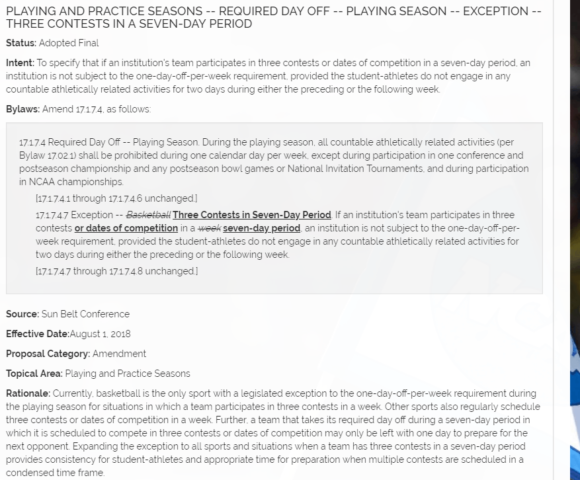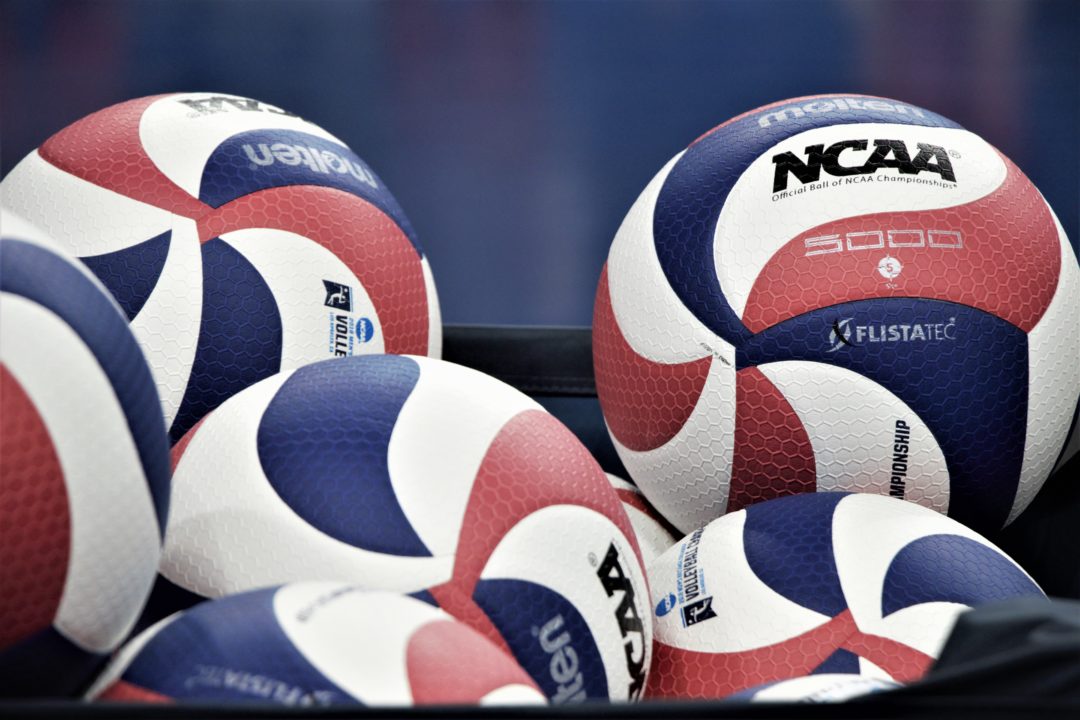Following a recent rule change by the NCAA, student-athletes will lose their guaranteed weekly day off and now could be required to train for up to 24 consecutive days without rest. Though the NCAA is not officially changing the rule to require 24 days of consecutive training, it is now a possibility and it will be up to each NCAA Division I member school to decide what to do.
The former rule required student-athletes to receive one day off per week, which was typically Sunday, unless there was competition on that day. The new rule says that if an institution’s team participates in “three contests or dates of competition in a seven-day period,” that the one-day-off-per-week requirement doesn’t apply, so long as either in the week before or the week after, that day off is made up (in other words, 2 days off instead of the usual 1 during the week before or week after). Basketball previously had this exception, and it will now extend to other sports as well. Notably, that includes swimming, where especially invitational meets often add up to three competition dates, or more, in a seven-day-period.
The exact text of the approved change:

It is important to note that the rule change will not reduce a student-athlete’s total number of days off throughout an athletic season, though it will allow Division I member schools to shuffle when those days fall over the course of a 28-day cycle. Thus, a Division I member school may now create 28-day training cycles in which days 1 and 2, are off-days, days 3 through 26 are blocked for training and competitions, while day 27 and 28 are off again, thus creating the 24-day training block. In other words, a situation can arise with a week that has 2 days off, consecutive weeks with 3 competition dates, and then a 4th week with 2 days off.
Here is what a 24 day block without a rest day would look like:
- Week 1: 2 days off, followed by 5 days of training.
- Week 2: 4 days of training followed by 3 days of competition.
- Week 3: 4 days of training followed by 3 days of competition.
- Week 4: 5 days of training followed by 2 days of rest
The present system stipulates that during the playing season, “all countable athletically-related activities are prohibited during one calendar day per week, except during participation in one conference and postseason championship and any postseason bowl games or National Invitation Tournaments, and during participation in NCAA championships.”
The new rule, which will become effective on August 1st, reads:
“…if an institution’s team participates in three contests or dates of competition in a seven-day period, an institution is not subject to the one-day-off-per-week requirement, provided the student-athletes do not engage in any countable athletically related activities for two days during either the preceding or the following week.”
The new time off rule was originally proposed last August by the Sun Belt Conference, which noted that basketball, the only sport with a prior exception to the rule, was not the only sport to regularly schedule three consecutive competitions or three-day long competitions. The NCAA Swimming and Diving Championships and most conference championships take 4 days, for instance.
We can imagine how this might influence swimming: if a student-athlete competes at the Big Ten Swimming & Diving Championships and qualifies for the NCAA Championships, normally they would have to take the Sunday following the competition off from training–all athletes that do not qualify for the NCAA Championships would have to take an entire week off per current NCAA rules as their season has ended. Next season, however, athletes and coaches could return to training the day immediately following their conference championships.
For reference, the 2018 Big Ten Championships and the 2018 NCAA Championships for both men and women were bridged by exactly 24 days (Sunday, February 18/25 – Tuesday, March 13/20). However, given that no one is taking the day before Big Tens off as a rest day, and since Big Tens and NCAAs both count as four days of competition each, there is no viable way swimmers and coaches could train every single day between the two meets and remain compliant with the rules. Thus, for swimming and other sports like track & field, it is unlikely this particular rule change will affect student-athletes’ schedules and training methods very much.
In 2017 the NCAA eliminated two-a-day contact football practices, a move which drew criticism from football coaches and players as it meant they had to drag training camp out for five weeks instead of the traditional four weeks in order to fit in all 29 allotted practices. Though this rule was intended to keep athletes safe, two-a-day practices had already become a relic of the past, with only a few doubles actually being on the calendar during a college football training camp. This new rule, however, will not fix football training camps, since even with the possibility of practicing 24 days in a row, without doing a handful of doubles, there will be no way football teams can cram in all 29 of their allotted practices.
In order to determine whether eliminating the mandatory day off for participating Division I programs is a net positive or a negative, one has to consider the veracity of the coaches and the athletics department at a given institution. If a coach is prone to working their student-athletes relentlessly and prizes athletic performance over GPA, the rule change could be harmful. If, however, the coach genuinely cares about their athletes’ lives outside the pool, off the court, etc., then there is likely nothing to worry about. However, some fear the NCAA has set a dangerous precedent with this rule change, claiming it might allow for greater exploitation of student-athletes.
This move has initially drawn criticism from NCAA fans and onlookers, in contrast to another new rule announced adopted by the NCAA this week regarding the “notification-to-transfer” system for student-athletes wishing to depart from their current programs. Student-athletes no longer need their current institution’s permission in order to contact other institutions with the intent to transfer, a move which undoubtedly gives power to student-athletes. Previously, student-athletes wishing to transfer had to receive permission from their current school before reaching out to another. Though the old rule was intended to prevent NCAA Division I coaches from recruiting athletes from other Division I programs, it also gave coaches too much authority over their athletes’ lives as it allowed them to prevent their athletes from transferring away to other programs.
Of course, the elephant in the room whenever NCAA rule changes are being discussed is whether or not student-athletes deserve financial compensation beyond scholarships. Public opinion is split, and the conversation is more complex than it may seem, and both sides can site statistics that claim the majority of the population agrees with you. That issue, which underlies every discussion about players’ rights, will continue to infiltrate discussions regarding the demanding lives of Division I student-athletes until players, coaches, and NCAA decisionmakers reach an agreement that all parties feel is fair.

Leave a Reply